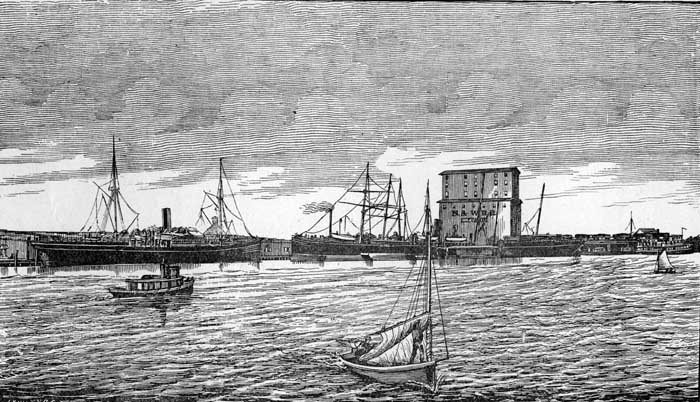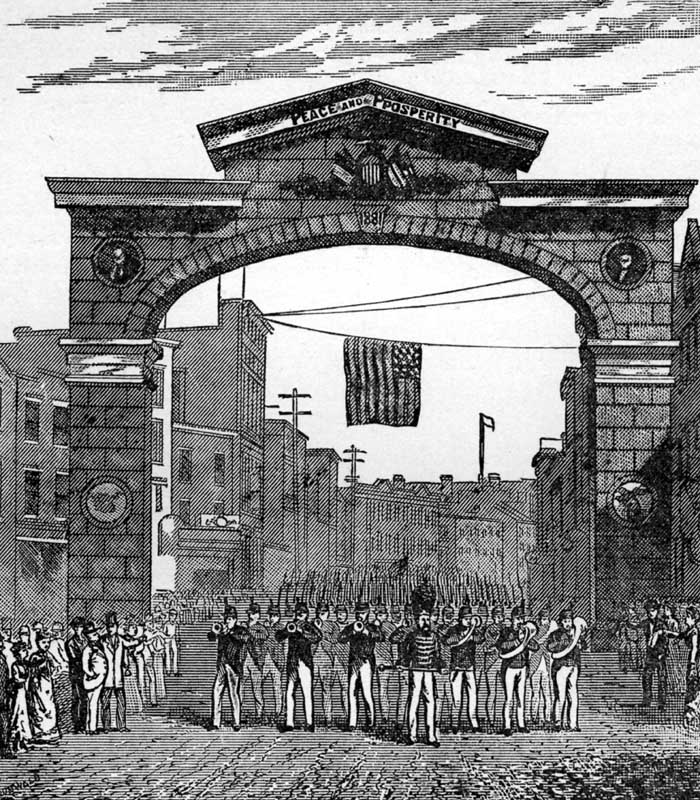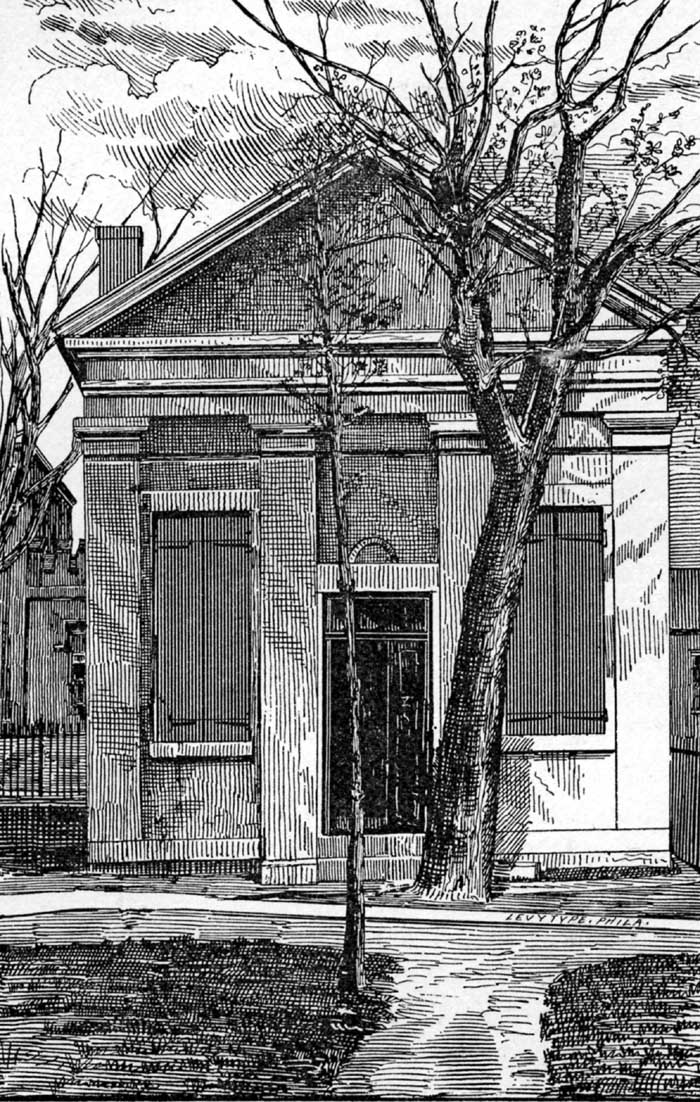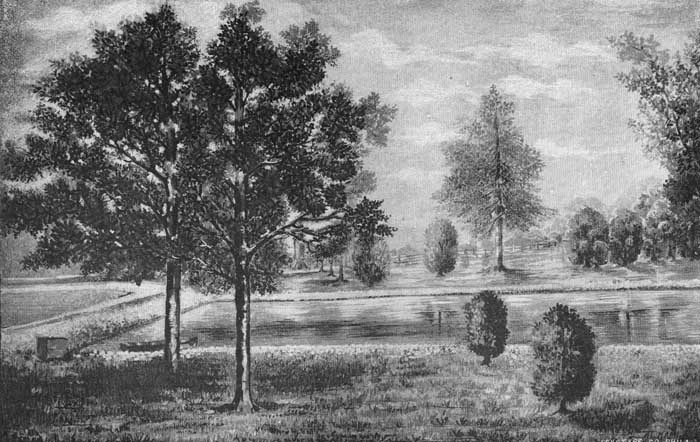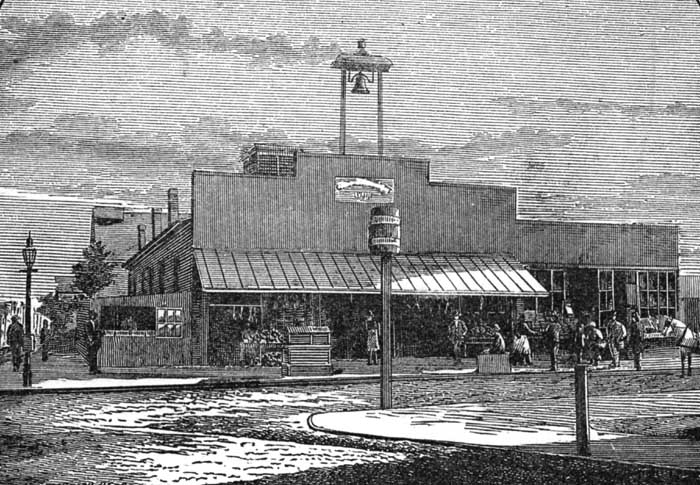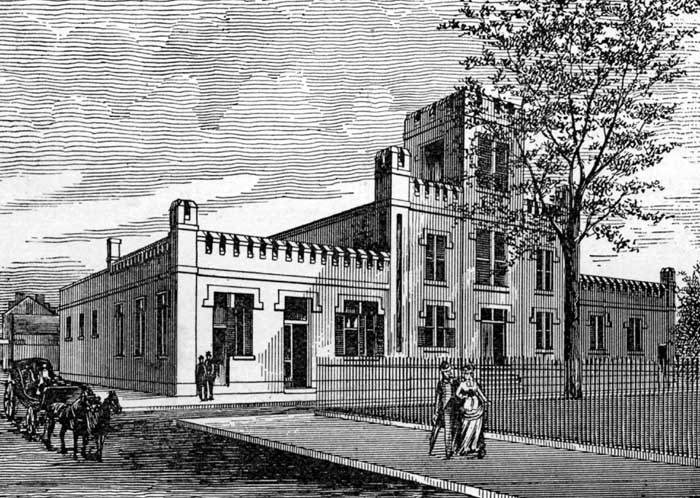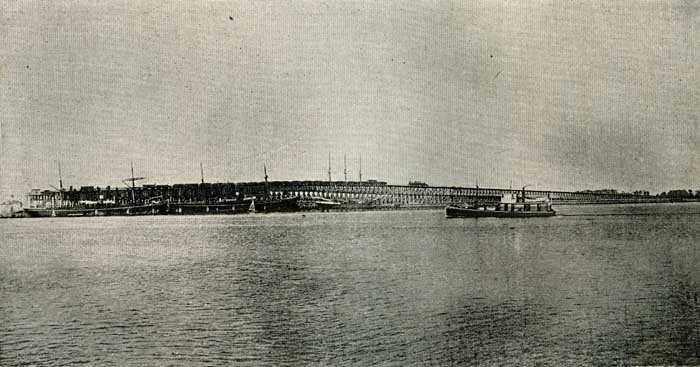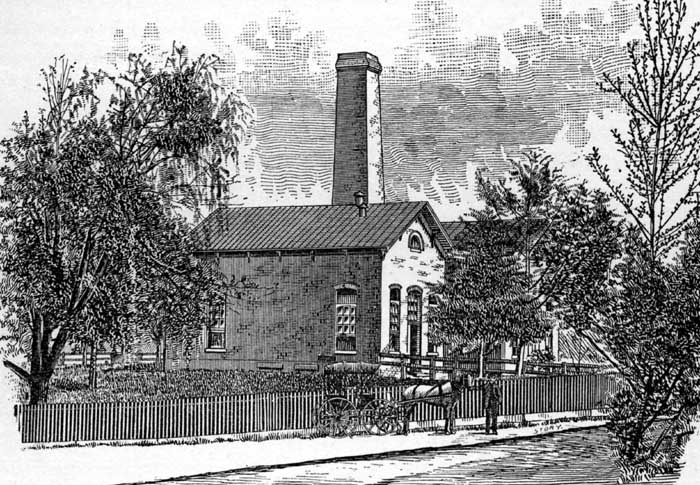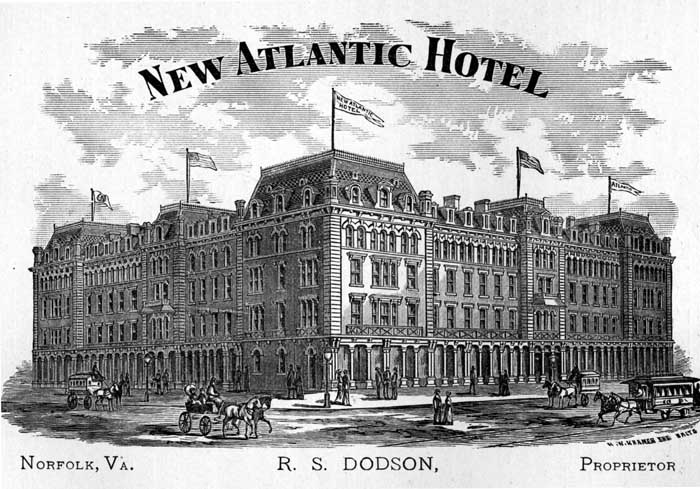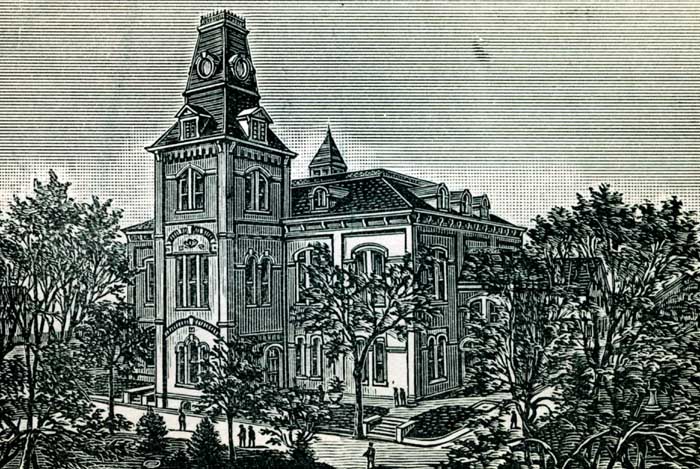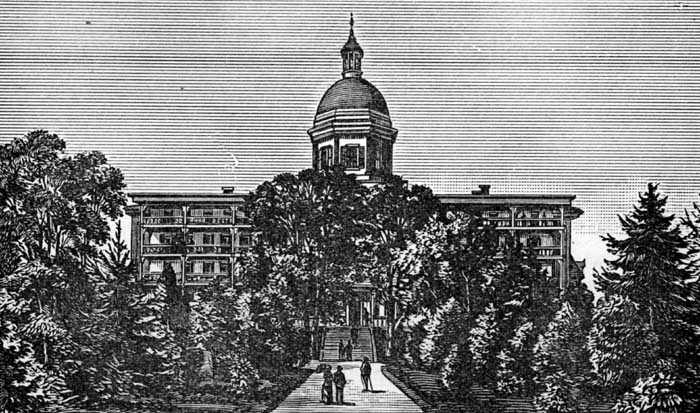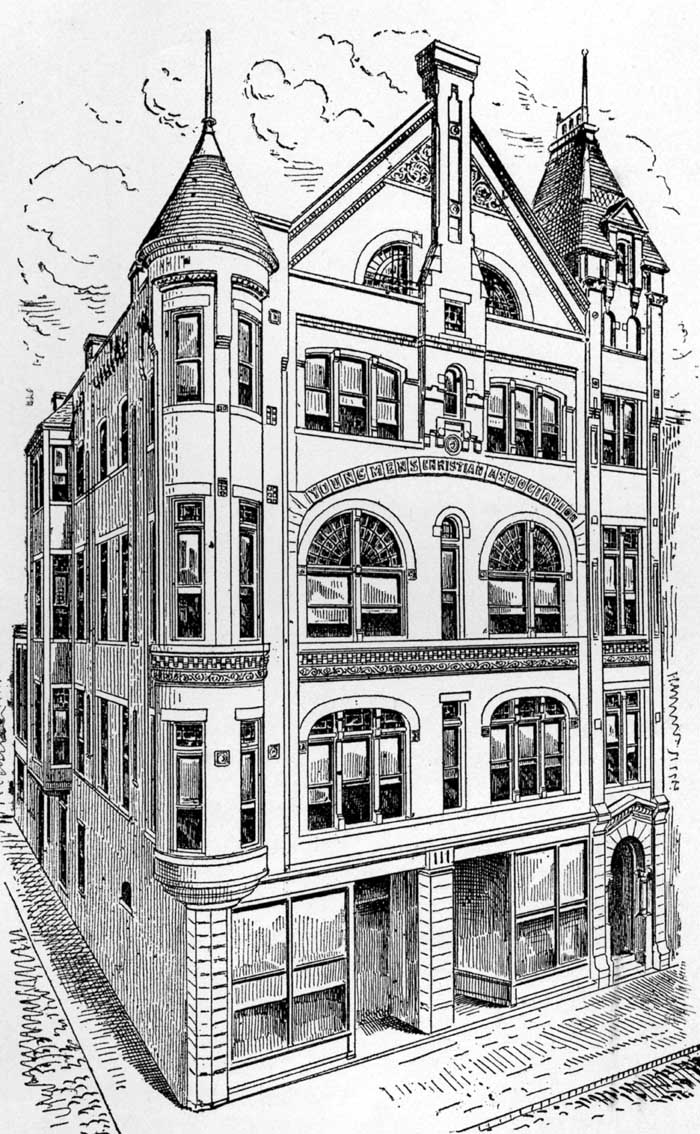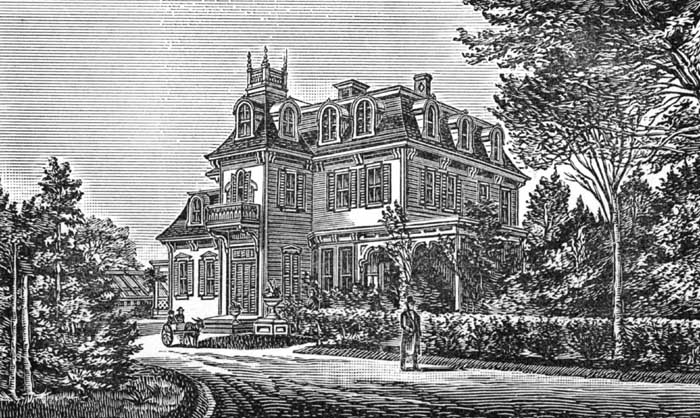OUR TWIN CITIES
OF THE NINETEENTH CENTURY:
NORFOLK AND PORTSMOUTH
THEIR PAST, PRESENT AND FUTURE.
Robert W. Lamb, Editor.
Norfolk, VA: Barcroft, Publisher.
1887-8.
Norfolk Landmark Steam Presses.Reproduced by Donna Bluemink.
Continuation.
p. 56. Grain Elevator and Docks, Norfolk and Western Railroad.
[ 57] CHAPTER III.LET us return now for a while to our railroad connections with the interior and find what has been done towards the improvement and development of the natural advantages of our cities by the sea. The new organization of our friend under the title of the Norfolk and Western Railroad soon gave evidence of the regard in which it held its eastern terminus, whose name it bore, for speedy steps were taken to improve the stations, grounds and depot at this point, and in 12 months the handsome Queen Anne passenger depot and extensive sheds adjoining for offices which now adorn that portion of the city had replaced the old forlorn structures. The improvements to the wharf front were completed as rapidly as possible until an unbroken line of nearly one-third of a mile was obtained, with ample depth of water, where domestic and foreign freight steamers can be unloaded at will. Large storehouses were immediately erected and others projected to be built as rapidly as business demanded.
In October, 1881, the N. and W. Railroad united with the S. V. Railroad and E. T., V. and G. Railroad and its leased connections in forming that tripartite contract for 25 years for joint traffic management. This practically formed a great through or trunk line between Norfolk, Memphis, and in fact other points in the South and Southwest on the E. T., V. and G. Railroad connection, and may in time lead to a great highway between the Atlantic at Norfolk and some desirable point on the Pacific Slope. This combination, under the name of the V., T. and G. Air Line, is now well known to our citizens, particularly those of the Cotton Kingdom, through the energetic efforts of its agents in this city to build up and maintain her rank as a cotton port. On March 16,1882, the Norfolk Terminal Company was organized for the purpose of constructing, owning and operating a railway with all necessary tracks, &c, from any point on the Norfolk and Western railroad in the county of Norfolk to any point or points at or near the harbor of Norfolk, on Chesapeake Bay, in the counties of Norfolk and Princess Anne. It was also authorized to construct at or near the harbor of Norfolk, wharves, docks, warehouses, elevators and cotton presses suitable for the accommodation of steamships and vessels and for the convenience of shipping, transporting and storing all kinds of merchandise and property, and the company may also conduct a general dock, wharf, warehouse, steamship and lighterage business. The company was also authorized to consolidate with the Norfolk and Western Railroad and to issue mortgage bonds, secured in the usual way. Its [58] minimum capital was $100,000, with the privilege of increase to $5,000,000. This organization, which is now owned and controlled almost exclusively by the N. and W. Railroad, soon commenced a good work in and about the harbor of Norfolk, of which we shall have more to say further on. It is our present wish merely to call attention to the provisions of its charter and then proceed as this historical sketch is developed to point out how faithfully they have been executed and with what great benefit to the trade and commerce of our community.
The Seaboard and Roanoke Railroad, though its terminus is on the southern side and may therefore claim to be allied more closely to our sister city, belongs in truth to our common harbor and has been no small factor in promoting its growth and commercial importance; and we therefore turn with great pride to the large carrying trade which it does from our markets, as well as to its immense business as a transporter of cotton, which it brings to them in exchange for the fertilizers and other merchandise previously carried. In 1881, to meet the demands of this trade, we find several immense warehouses erected for the storing of several millions bags of fertilizers from our home market and the Northern ones, and of other articles of produce and merchandise, and an addition to their terminus on the southern side of the harbor, extensive dock facilities with a frontage of 500 yards, besides the purchase on the Norfolk side, at an original cost of nearly $30,000, of a valuable site for a wharf and dock on an extensive scale, which was subsequently improved to keep up with the business ideas of the times.
The year 1881 witnessed the opening of another link of our communities to the Old North State, our foster mother—the Elizabeth City and Norfolk Railroad to Elizabeth City on June 1, and to Edenton on December 16, with its northern terminus in the neighboring village of Berkley. The site chosen was an admirable one, as it offered extended room for wharf facilities as the demand increased, besides tending greatly to the further improvement and development of our common harbor. Its advent among us was hailed with great joy, as it promised large benefits in the way of opening up to our markets, with greatly improved facilities, the well-known products of a section from which, through our canals, we had already drawn heavily, but which we believed would prove all the more productive, with its three busy seasons, trucking, fishing and cotton, as the opportunities for transporting their products to market were increased. Nor has this promise failed of fulfillment.
It was early in this year that the necessity of getting rid of the surplus water which began to accumulate in our streets and lots in consequence of the increased demand and use of water from our city Water Works, as a sanitary measure, began to impress our City Fathers to the extent of appointing a committee to consult with an eminent sanitary engineer in [59] order to adopt a proper plan for effecting such drainage as might be best suited to our soil and topography.
The preliminary report was submitted in April, 1881, and a further report in June, which was referred to the new Councils, who came into office July 1. It would seem that the Councils were not very seriously impressed with the necessity of prompt action from a sanitary point—at least it is to be hoped so—as they permitted the fall and best half of the winter to pass before the important work was commenced. Six years have nearly passed—and to-day witnesses the system, which will doubtless be very thorough when accomplished, still incomplete, many of our important thoroughfares being in a state of sad upheaval—giving full opportunity for our people to enjoy the winter's mud.
Yorktown Centennial, Main Street Arch.
Well, ours has always been a city of great expectations, and as we have been raised on hopes we can live on them; but we long for better things [60] to bid welcome to enterprising strangers who may seek homes and new fields of industry within our gates.
And now, before bidding farewell to the year 1881, we linger to give a passing notice at least to one very pleasant feature that brought out our city in what we might with some propriety style the old borough light; or rather, perhaps, we should say in a new—that is, an electric—light.
The sad circumstances attending the lingering illness and death of President Garfield had thrown somewhat of a damper on the earlier preparations for the Yorktown Centennial, which had been proposed and to a considerable extent brought about by the enterprising proprietor of the Norfolk Virginian, and our citizens determined to use their best efforts to make our city shine resplendent on the occasion of this Virginia celebration.
On October 11 a proclamation by the Mayor requested an active participation by all citizens in a week of festivities from Monday, the 15th. He specially invited the large fleet of British vessels lying at our wharves to participate in this celebration, as they now gave our port "a great victory of peace, instead of the dread alarm of war which the British fleet created one hundred years ago." And our people, laying aside their sorrow for the dead ruler, gave themselves up to the full enjoyment of the proud occasion.
It was a sight to see the throngs by day wending their way through the triumphal arches adorned with appropriate mottoes and pictures, but a greater sight at night, in the full glare of the electric light, introduced into our city for the first time to grace the occasion, the old and staid citizen vieing with the child in merry amusement to honor our great centennial. The many visitors were much surprised at the life manifested in our community, which was completely at variance with their preconceived notions of our slow, conservative old city. They didn't know our boys, and that even the old terrapins, when the fire of enthusiasm warms through their thick shells, can move around lively enough.
The year 1882 showed evidences of advance in every branch of trade, and the Norfolk boom may be said to have fairly set in. During this year the handsome improvements at the N. and W. Railroad passenger depot were completed and the two large freight warehouses on the water front for the storage of cotton and merchandise for coastwise or foreign shipments. The value of the exports for this year, which embraced of course four months of the season of '82-3, reached a higher figure than ever before, and is, in fact, in excess of any of its successors until 1886. The season of 1882-3 was indeed a most remarkable one, our total cotton receipts having reached the unprecedented and since unequalled figure of over 800,000 bales.
[61] The lumber business of this period was also very extensive and reached in value the handsome sum of $200,000 for the year 1883, of which fully one-fourth was shipped to foreign markets.The peanut crop, which had so largely declined in the previous year, once more exceeded a million bushels in Virginia in 1882 and again in 1883, and our market came in as before for its full share, 75 to 80 per cent, of this trade, with appreciating values occasioned by a growing demand in excess of the increased production.
Granby Street M. E. Church South.
In 1883 our trade exhibit showed a business of $55,011,656, as against $38,200,436, or an increase of over 45 per cent.
The N. and W. Railroad completed its new river branch from Central (now Radford) to Pocahontas in 1882, and thus connected our city directly with the inexhaustible coal beds of Virginia, and on the 17th day of March, 1883, the first carload arrived, consigned by President Kimball to the Mayor of the city. Its arrival was duly celebrated by a display of bunting from all the public buildings and shipping and by a salute from [62] the battery of the Norfolk Light Artillery Blues. This car was the precursor of a trade which has already shown a magnificent development and is yet in its infancy.
The Merchants and Manufacturers' Exchange of Norfolk and Portsmouth was revived and reconstituted during this year, and is now in active and useful operation. We give below an extract from a preamble to a set of resolutions embodying a petition to the Senate and House of Representatives from this body presented in 1883 and asking an appropriation of $100,000 for the purpose of widening the channel of the eastern side of the Elizabeth River from Port Norfolk along the new Port Warden's line to Lambert's Point, which gives the condition of our city at this date as shown by the records:
"Whereas the city of Norfolk, which has long had a national prominence from the excellency of its harbor, the site of one of the finest navy yards in the United States, has within the past few years exhibited a most extraordinary development of its foreign trade, which for exports has reached a valuation of over sixteen million dollars during the past year, while its general business in the three years since 1880 shows a gain of over 40 per cent., with an increase of population in the same time of 20 per cent.; and whereas despite the construction in a single year of nearly three miles of wharf front on our common harbor to meet the demands of trade, our facilities are yet inadequate to do so in the present limits of the harbor; and whereas the southern branch of the Elizabeth River is so fully occupied by the shipyard and dock of the U. S. Government on the one hand and the manufactories of fertilizers and lumber mills on the other, while the obstruction of the eastern branch by railroad and other bridges prevented an extension in that direction and in consequence rendered it necessary for further improvements to be made down the harbor along the usual channel way for incoming vessels, to meet which demand the Harbor Commissioners have elongated the Port Warden's line from Fort Norfolk to Lambert's Point," &c, &c.
On the 8th of February the Mayor brought the subject of lighting the city with electricity before the Councils in a special message, which was referred to the Committee on Lights, who subsequently made a favorable report, resulting before the close of the year in the city receiving an electric illumination, which had grown very popular two years before, during the Yorktown Centennial. The telephone fire alarm also came into use this year.
On the 16th day of October, 1883, the remains of a number of Confederate heroes, who gave their lives for the lost cause, arrived in our city en route from the National Cemetery at Arlington in charge of the Ladies' Memorial Association, to be buried in North Carolina, the land of their birth. They were received with due honors by our municipal authorities and citizens without regard to past differences. The occasion is one [63] which will long be remembered in our midst as tending greatly to obliterate the asperities of the past, while it kept alive in the hearts and memories of our young the undying love we bear for those who wore the gray.
November 12, 1883, the Mayor in that portion of his annual message referring to the Water Department called especial attention to the report of the Chief Engineer, and urged immediate action, as the Water Works had ceased to be the efficient agent they formerly were in extinguishing fires—which alone was sufficient to awaken our gravest apprehension— and similar words of caution on the subject in its various phases. As if to give point to these words of warning, the next day the disastrous fire at the N. and W. Railroad occurred, which proved the inadequacy of the [64] city's water supply and resulted in the destruction of a large warehouse and several thousand bales of cotton in and around it.
The year 1884 was unquestionably one of general depression, and in a community that had attained the commercial importance of our own it was necessarily felt to a considerable extent, and the result was a decrease in business generally of fully 20 per cent. In no line of trade was there an increase, but the coal and wood business probably kept up more nearly to the usual mark. The severe drouth played sad havoc with that important interest the trucking business, as it was reduced nearly one-half, which would have been ruinous had not prices consequently ruled high, thus making amends to a considerable extent at least for the decrease in quantity. The foreign trade for 1884 showed an increase over the previous 12 months both in tonnage and in value of cargo.
The experience of 1883 having taught a severe lesson, steps were taken this year to increase adequately the water supply, and to accomplish this the wooden conduit between Lake Lawson and Moore's Bridges was replaced by a 20-inch cast-iron pipe and a larger main, 24-inch, laid between the reservoirs and the city. A proposition was also started to increase the water supply by connecting Lake Lawson with Lake Bradford, an adjoining body of water. The quality of the latter was pronounced to be pure and free from deleterious matter by a competent chemist.
Section B of the Waring system of drainage was given out to construct and nearly completed this year. The old canal from Bank street to Granby street, so long an eyesore, was filled in and an outlet for drainage afforded by an iron conduit four feet in diameter laid along the former ditch.
This improvement gave us a wide and handsome thoroughfare, appropriately styled "City Hall avenue," while the old landmark "Stone Bridge," on Granby street, is now a thing of the past.
The new route from New York, which puts our city within about 12 hours of the metropolis, was opened in November of this year under the title of the New York, Philadelphia and Norfolk Railroad, with its terminus at Charles City, from which cars were transferred on barges to their wharves at Portsmouth and Norfolk. At the former place it was proposed to make close connection with the Seaboard and Roanoke Railroad for Florida.
City Water-Works. Settling Reservoirs.
The Norfolk and Virginia Beach Railroad and Improvement Company, whose line was opened up to Broad Creek in 1883, effected an arrangement with the N. and W. Railroad this year by which they came into the yard of that road over a trestle, using the depot of the N. and W. Railroad as their station until their own was completed. This has been another means of healthful enjoyment to our people and many visitors from abroad, though it is yet to prove the pecuniary success which its fine location merits. During the year the work on their Lambert's Point [65] property was commenced and pushed vigorously by the Norfolk Terminal Company.
The National Compress Company was also organized, and erected its mammoth press, said to be the most powerful in the world, on the Boston wharf, the site of the press of the old Virginia Compress Company.
In Portsmouth during this year we find much improvement in the pavement of streets. The refitting of the Ocean House, long disused, and its conversion into an attractive, first-class house, supplied a long-felt need in the community. A fine brick public school-house was built, and the erection of water works was commenced and nearly completed. A bill also passed Congress for a new postoffice. Spacious wharves, from which loaded freight cars are ferried to Norfolk, were completed by the Seaboard and Roanoke Railroad, while many new buildings were erected and plans adopted for inaugurating several manufacturing industries so soon as the necessary water supply is obtained.
There was great activity shown in the erection of new buildings during the year in Norfolk—a good evidence of an ample amount of capital being in hand. City Engineer Brooke defined the lines for 283 new buildings, of which 160 were brick dwellings, 8 brick stores, 4 brick warehouses and 111 frame dwellings. This was an increase of 149 over the preceding year.
[66] We come now to 1885, one of the most remarkable years in the business history of our communities. There was unquestionably a general depression in trade throughout the country, and especially in Virginia, during the year, but the energy and true solidity of our business houses were superior to an emergency which would have crushed many a community of far greater vim and commercial life than we were reputed to have.
During February, the month when the fire fiend is almost inevitably at work, a fire occurred in a large cotton warehouse on Town Point known as the Gwathmey building, and when discovered the three floors filled with cotton were afire. At the early hour, 4 A. M., in the morning of the 25th there was a stiff breeze from the west, and the fire burned so hot that it became almost impracticable to approach the building. Sparks were also carried to a considerable distance, and, entering through a broken window, set fire to another cotton warehouse, thus producing two large cotton fires at one time.
We mention this instance to call attention to the admirable work done by that excellent organization the Norfolk Fire Department, which has entirely superseded the old volunteer fire companies. It is claimed that the salvage of cotton at these two fires by a comparatively small organization will challenge comparison with similar work done at any cotton fire in other cities. In fact, the excellency of this department of our city government is impressing itself upon our community more and more every year, and large and disastrous fires have now become a thing of the past. Incidentally we would here remark the telephone alarm system, which was established in 1883, proved very useful and effective, but has been recently superseded, in 1887, by the Gamewell electric alarm, which is claimed to be much more efficacious.
Our city is certainly wide awake and up to the times in many respects, which perhaps makes its defects in others more apparent.
March 1 the N. Y., P. and N. Railroad, which had made its connection with our cities by a steam ferry from Cape Charles City in November of the preceding year, completed its arrangements by which it superseded the Canton Inside Line, the Pennsylvania Railroad making its connection for Philadelphia business with this road at Delmar, Del., in place of that with the Baltimore Steam Packet Company at Canton, Baltimore, as heretofore.
Connections were made at Norfolk with the N. and W. Railroad for through passengers and freight for the Southwest and West, at Berkley with the Norfolk Southern for the Sound regions of North Carolina, and at Portsmouth with the S. and R. Railroad for the South.
In speaking of previous years we have already alluded to the Norfolk Terminal Company, which was chartered in 1882, its object being to enable the N. and W. Railroad to provide those extended terminal facilities at Norfolk which were found to be so requisite for the proper conduct of its [67] business, but which under its charter it was not empowered to make. During the year 1884 the necessary right of way through the suburbs of the city had been secured and a road extending from the depot yard at Norfolk to Lambert's Point, a total distance of a little over five miles, had been constructed.
The company had purchased 483 acres, with a water front of 1-2/3 miles, at Lambert's Point, and completed in 1884 at this point the longest coal pier in the world. The pier, exclusive of the approach, extends out to the Lambert's Point Lighthouse, a distance of 894 feet, with a width of 60 feet and an extreme height above high-water mark of 48 feet. The cost of these improvements amounted to $305,000.
Active operations were commenced at the pier on March 12, 1885, and have been since continued with unvarying success.
But so far we have only spoken of what might be considered the business success of the year—a theme upon which it certainly gives us more pleasure to dwell than the unfortunate event to which our character as a truthful historian compels us to revert.
April 2, 1885, is a day which our sister cities will not be likely to forget for many a decade; and though continued prosperity may obliterate entirely the effects, memory will hold a sting that will constantly recall the day and its disasters, which broke upon us, who were not in the little ring of financiers whose deeper knowledge of the inner workings warned them of the approaching storm, like lightning from a cloudless sky. On that day the Exchange National Bank of Norfolk and the Banking House [68] of Bain & Bro., of Portsmouth, were compelled to close their doors, and just one week later the Farmers' Bank of Norfolk was compelled to suspend. Over four millions of dollars were thus suddenly withdrawn from use, and two financial institutions which were regarded as Gibraltars in their line and enjoyed unlimited public confidence, collapsed almost like a bubble. There was a great deal of ill-feeling aroused, and perhaps justly, but upon the whole the conduct of the two communities was admirable and worthy of all praise. Citizens of all classes were involved, and some unfortunate ones lost their all, but the general result was unparalleled in the history of similar failures in other cities. For as time glided by and further developments of financial weakness were anxiously awaited without the unfortunate results anticipated being realized, it was found that our business houses had developed an unexpected strength and not a single private failure had followed. The investigation into the affairs of the Exchange National Bank brought to light the fact that it had really been insolvent for years, its largest assets being investments that had gotten to be hopelessly worthless, and the large amount apparently on deposit had long been withdrawn from general circulation. And here we may be permitted to say, while not pretending to decide the actual merits of this particular case, that we do not consider the result necessarily showed moral turpitude on the part of the managers of the bank. A combination of unfortunate circumstances often compels men in such situations to assume grave responsibilities, and unfavorable results almost inevitably place their conduct before their fellow men in a false light. A character in the past for probity and honor should not be swept away in a day by appearance of evil, and we must combat our prejudices that lead us to do so. But perhaps Talleyrand was right—"a blunder is worse than a crime."
But leaving out the matter of judgment as to the causes of the failures, there can be but one opinion as to the pluck and energy displayed by the business men of our sister cities to retrieve their losses and restore the credit abroad of our two communities.
We find before the expiration of a year a strong institution established in Norfolk, the Norfolk National Bank, with an actual capital of $400,000, which is considerably larger than was the apparent capital of its predecessor the Exchange National Bank, whose building it purchased and now occupies. The other banking institutions of our community also increased their capital stock, and enjoy the full confidence of our citizens. Across the water many of the leading merchants and other business and professional men united in incorporating the Merchants' and Farmers' Bank of Portsmouth, which now enjoys with its older sister institution, the Bank of Portsmouth, the well-merited confidence of that community.
Lambert's Point Pier, (Norfolk and Western R. R.)
Upon the whole the result of these unfortunate failures, which at first promised to be so disastrous, has been to give a healthier tone to the moneyed transactions in the two cities in making men more cautious without [69] breaking down proper confidence between man and man—in putting into active circulation by the erection of handsome and useful dwellings and stores, which are now springing up in both cities in all directions, the money which would have otherwise remained in the banks in comparative idleness, drawing a rate of interest hardly compatible with continued solvency. The nine per cent, rate of discount, in the new order of things has now given place to the legitimate six per cent.
We think no stranger evidence of the truth of our position that out of the weakness and failure of the spring, energy and determination have won success in the fall campaign of business can be given than is shown in the following significant comparison between the figures of the totals of the Clearing House transactions of the combined banking institutions of our two communities during the month of November—which we select as the height of the cotton season—of the year preceding and that following the failures of April:
1884.................................................................$3,891,700
1885.................................................................. 5,592,900
We note this year a new departure in building in Norfolk—the Dodson building, a five-story marble front, on Main street; the first floor occupied by the Citizens' Bank, the second floor the new quarters of that admirable institution the Norfolk and Portsmouth Cotton Exchange, while [70] the upper floors are the working homes of busy men in railroad and other offices.October 20 the Norfolk Terminal Company completed two substantial brick warehouses on the water front at Norfolk of the N. and W. Railroad to meet the increasing demand for safe and eligible storage of cotton and other products from the interior. They have a frontage of 205 feet each and a depth of 95 feet, and are constructed in four fireproof departments. A large number of fire plugs, conveniently situated, can also furnish on occasion an ample supply of city water. The same company specially equipped the north side of their coal pier at Lambert's Point during this year to enable them to supply ocean steamers, on call, without detention. During this first season—March 12 to December 31, 1885—45 ocean steamers and 357 vessels of other kinds were furnished a total of 298,401 tons of steam coal from the Pocahontas mines. The total cost of the improvements by the Terminal Company for the year aggregated $135,333. The total of the trade exhibit for the year 1885 as compiled on January 1, 1886, footed up $51,651,585 for the city of Norfolk.
There are very few, if any, striking events to mark the history of our communities during the year 1886. A vigorous and healthy reaction had followed on the depression of the preceding year, and our sister cities seemed to have started afresh on the highway to prosperity.
One event in religious circles was of particular interest—the advent in our midst of the eminent evangelists Moody and Sankey, whose successful work in the service of the Master is known and felt almost throughout the civilized world. The effect upon our community, especially upon the younger portion, was very beneficial and to a considerable extent lasting; and one admirable suggestion, the erection of a Y. M. C. A. building by the organization to whom we owed their presence in our midst, has developed into an ornament to our city on its principal thoroughfare, where our young men are provided with a resort in which healthy and rational amusement for mind and body can be provided at a small expense, while their higher and eternal interests are looked out for.
The magnificent choir which took part in the services celebrated during Moody and Sankey's visit in April, 1886, in the large warehouse of the S. and R. Railroad, on the Norfolk side, was made up of the best musical talent of both cities, under the leadership of Prof. Newton Fitz, of Norfolk, and elicited the encomium from Sankey of being the finest organization of a similar character that he had met in his travels. Those who heard their hearty, soul-stirring music can alone appreciate its excellence.
But we must turn once more to the workings of Mammon and leave the pleasant thoughts of our better nature—our higher life.
The export business of our port during the year ending December 31, 1886, reached the handsome total of $15,205,404, of which $14,672,632 represented cotton shipments only.
[71] This fall saw the inauguration of the Monarch line of steamers from our port to Liverpool and London, which is still running, with fair chances for success, and is thus the first permanent line which has ever been established.
The imports for the year amounted to $82,598, the principal article being salt, to the value of $57,662, and the next kainit for the manufacture of fertilizers, which is largely conducted on the southern branch of the Elizabeth River, just above Portsmouth, amounting in value to $18,914. On August 31 our sister cities experienced the earthquake shocks, so generally felt throughout the country; but while many deserted their houses temporarily, and doors and windows rattled, clocks stopped and pictures vibrated on the walls, nothing serious occurred, and we have only a rather pleasant memory of what was in the light of what might have been the experience of our less fortunate sister towns. Either we were merci- [72] fully spared a severer shock in view of the heavy afflictions through which our communities had already passed, or the light and yielding nature of the soil on which we stand precludes the possibility of a very disastrous shake.
We turn again with pleasure to the continued improvements in our harbor by the Norfolk and Western Railroad through the medium of the Norfolk Terminal Company. As we have already mentioned, it was a subject of serious consideration when the city of Norfolk early in 1881 saw its large investments in the A., M. and O. Railroad slipping from its grasp and that valuable work with all its franchises about to pass into the hands of strangers. And it was a difficult matter at the time to make our people feel assured that the change which then took place would be for the best. It was only the most sanguine, who had an undying faith in the ultimate destiny of our cities by the sea, with their unparalleled advantages, that really put faith in the assurances of those who had good reason to know the intentions of the new purchasers. They certainly have proved themselves to be true friends to our communities, and if the result should prove to their advantage our people should be the first to rejoice at it, for they have done more to foster and develop the trade of our port than would have been done by many a management, though native to our State, but whose interests and associations connected them more intimately with other sections of it. Let us rejoice, then, that we have fallen into such good hands, that with foresight to develop judiciously their own resources to best advantage, have so materially helped us.
We must be pardoned for dwelling so much and so partially on this valued business feature of our port; for while it is true our personal interests are largely involved in its success, we are still willing to give due credit to all other connections that are lending valuable aid to build up and develop the interests of our communities; but we think it obvious to every candid observer that the N. and W. Railroad, with its extended connections to the Southwest and West, is after all the main artery that will bring the needed supplies to establish our commercial health and growth.
In this connection we note the handsome increase of business at Lambert's Point pier for 1886; 95 ocean steamers and 581 other vessels for American and foreign ports received 504,153 tons of semi-bituminous coal. This pier with its added facilities has now been developed into the first coaling station on the Atlantic coast, and is but the pioneer of a series of similar improvements by this company looking to the development of our harbor. Docks, elevators, cotton compresses and other requirements of the export trade will all soon follow in due course.
This company also holds admirable sites for ship-yards, dry-docks and manufacturing establishments on and near their extended water front, which will be disposed of on reasonable terms to reliable purchasers. In fact, we are advised that already negotiations have been begun, and ere [73] this may have been completed, looking to the erection of such improvements by individuals not connected with the company.
The Norfolk Terminal Company, wide awake to the necessity of the further development of the foreign trade of our port, which its facilities, backed by the energy of our merchants, had so far increased as to render it practicable to establish and operate a regular line of transatlantic steamers, leased a portion of Pier No. 1 on the N. & W. water front at [74] Norfolk and commenced the erection of an elevator in August, 1886, which has since been completed and successfully operated. The storage capacity of this first enterprise in a new field is 150,000 bushels, and its transfer capacity 12,000 bushels per hour.
Our port is now provided with the facilities for storing and handling grain, tobacco and other commodities which will furnish cargoes in whole or diversified when the cotton season is over.
The Terminal Company expended $78,067 during the year on its improvements, including the elevator.
During the year a very important change was made in all our Southern roads in reducing the gauge from five feet to the standard gauge of four feet nine inches. This tremendous change was made over thousands of miles of connecting roads so quietly, expeditiously and satisfactorily that traffic was not interrupted for three successive days.
The N. and W. Railroad was the only one in our vicinity which underwent the change, which permits complete physical connection with all other systems when traffic requires it.
Towards the close of the year the controlling interest in the preferred stock of the E. T., V. and G. Railroad, which formed at Bristol with the N. and W. Railroad the connection known as the V., T. and G. Air Line, was on the market, and an unsuccessful effort was made by the N. and W. Railroad to secure it and thus perfect and perpetuate the traffic union which already existed. Subsequently the property was secured by a competitive system, the West Point Terminal Company, upon terms which the sellers deemed more favorable, but have since found, we understand, not to be such golden ones as the glittering suggested. Many of our people have been very uneasy lest this purchase would result in the breaking up of a valuable connection so essential to our export trade and the maintenance of our relative rank as a port.
We do not believe it, however. The purchase, we think, of the E. T., V. and G. Railroad by the West Point Terminal was only a, speculative move, and their energies we think are all bent on increasing and developing the traffic of that road by means of the double outlet via Bristol and Paint Rock, so as to greatly enhance its market value and afford them the opportunity of unloading it en masse or piecemeal on the market.
The extension of the New River Division of the N. and W. Railroad through the Clinch Valley was projected at the close of this year and the route surveyed. This extension when carried out will make connection with the Cumberland Valley Branch of the L. and N. Railroad and give us a direct route to the West and Northwest independent of the present connection of the N. and W. Railroad at Bristol. These railroad extensions completed, taken in connection with the startling fact that St. Louis and Chicago are actually nearer our port than to the harbor of New York, there is little doubt that a large portion of the grain and meat traffic that [75] now finds its way to that great trade center can be induced by additional facilities to seek foreign markets from our shores.
The year 1887 has now been reached, and the part of the historian has almost been played as the "now" stands before us in all its beauty and majesty of promises fulfilled; and yet we can hardly grasp it, so narrow is that line between our past and future which we vaguely call the present.
For years the old boundaries of Norfolk had existed—for a century, we may say—and the water-courses that bounded it on nearly every side seemed an impassable limit. By agreement, in consideration of right of way, however, the Norfolk Terminal built a solid roadway of shells through the depot yard of the N. and W. Railroad up to the dividing line of the city limits—Mahone's Canal—and this was spanned by a substantial bridge, which soon made this route the favorite thoroughfare to those going out to or coming in from Brambleton and the adjacent country.
WARD MEMORIAL HALL, SOLDIERS' HOME, HAMPTON.As might have been expected, this close connection was followed by a move towards a closer union, resulting in legislative enactment by which what had been heretofore known as Brambleton on the 1st day of July, 1887, became a part of the city of Norfolk —Brambleton ward, or, as it is fast getting to be called, East Norfolk. Brambleton, as admitted, embraces the original farm of Geo. Bramble, consisting of 245 acres, on which up to 1870 only one white family resided, and the older suburbs of Mayfield and Georgetown. The Rubicon, as we may now style Newton's Creek, has been crossed, and for the present the "Ohio" is our eastern boundary. This thriving suburb has brought some 2,500 addition to the city's population, giving us now an aggregate of over 30,000 people. No doubt when the enterprising gentlemen who are prospecting a park on [76] Broad Creek have carried out their designs the city will soon push out its arms and scoop in the intervening territory up to that tributary to the Eastern Branch.
The bridging of Smith's (familiarly known as Pudding) Creek from the foot of Duke street and the laying off in building lots of the West End tract, which immediately joins the city limits and is by this bridge brought into most convenient connection with the city, evidently points to a further extension in this direction. In fact, any one who studies the growth and topography of the city must see that Huntersville and Atlantic City and the intervening territory must necessarily be brought within the next two years into the corporate limits of the city. This will bring the boundary line along the roadway of the Norfolk Terminal Company's railroad, and the march of progress having reached that point cannot be stayed until the Lambert's Point improvements are within the city limits and we shall have one corporation, healthy and growing, from Broad Creek to Tanner's Creek.
So much for our speculations; now let us return to the actual progression as shown by the records of 1887.
We have already referred to the enterprise of the Norfolk Terminal Company in beginning in August 1886 the erection of an elevator on the wharf front of the N. and W. Railroad at Norfolk, which was completed and ready for use in February, 1887. But our enterprising merchants, anticipating the advantages of these new facilities, were determined to go ahead without waiting for their completion, and we find a shipment early in that month of 63,055 bushels of corn for Hamburg, Germany, in the British steamship Albany, cleared by Reynolds Bros. This was the largest grain shipment ever made from our port and was pronounced by judges the finest ever made from the country. The greater portion of this cargo was received over the Norfolk Southern Railroad and delivered at their wharf in Berkley at which the steamer was loaded. The loading of this large cargo by hand in eight days was considered a very creditable feat; 45,000 bushels of this cargo was shipped by one of our enterprising and leading commission merchants.
This valuable trade feeder has now completed its arrangements with the N. and W. Railroad by which its trains come over the bridge of the latter over the Eastern Branch, and freight and passengers can now be delivered at the N. and W. Railroad depot with all the advantages of the elevator in handling grain. The coming in and departure of these additional trains at the N. and W. Railroad depot has added not a little to the scene of busy life and bustling activity.
Ten car-loads of Virginia and North Carolina corn consigned to Messrs. Goodridge, Field & Co., grain merchants of Norfolk, was the first grain handled in the new elevator.
[77] But we have now reached a point when we shall defer any further remarks on the business of the elevator and foreign shipments to a subsequent chapter when we propose to speak more at length on the subject of our harbor—its facilities and industries as they appear in 1888.
A brief glance around our cities by the sea to note the improvements already made or now in progress, and our task, at least in this branch of our subject, is done.
A stranger visiting our city at this time and walking about our streets would doubtless be shocked by their condition, but let him remember the stage of transition from bad to good is ever rugged, and when he is told that we are on the eve of completing a system of drainage almost perfect, and that when our streets emerge from their present condition it will be to reach a state of dryness and smoothness before unattainable, the present will be pardoned in the anticipation of a bright future.
The National Soldiers' Home, Hampton.
It is certain that the improved appearance of many streets by the handsome dwellings that are rapidly replacing ugly vacant spaces all over the city is making it more attractive, and the suburbs in every direction are so rapidly filling up with very presentable tenements that the present line of demarkation between city and county is fast becoming obliterated.
If an increase in the value of real estate be the real criterion of a city's progress, we think the following table of relative values of our West End property, which is devoted solely to residences, and which has been filling up rapidly in the last few years, is strong evidence as to our advance:
[78] Location. Price per fr't ft.
West Washington Street........1883 $40 and 1887 $ 80
Freemason St. .................................... 75 and 110.
Granby St. .................................... 80 and 100
York St. .................................... 70 and 110
Bute St. .................................... 90 and 120
Duke St. ..................................... 45 and 85
Boush St. .................................... 30 and 50
Grace St. .................................... 25 and 45
We leave the reader to calculate for himself the per centage of increase in each locality.Large as this increase appears, it becomes small when compared with the increase of values in Brambleton between 1885 and the time it became a ward of the city, lots valued at $200 at the former date having advanced in the two years to $600.
The West End Land Company, with a capital of $150,000, have recently put their lots on the market in this suburb recently connected with the city by a new bridge from the north end of Duke street; and in view of a probable annexation at an early day, there is every prospect of a big boom in this direction also.
Leaving the improvements of the city generally, we note particularly our Main street. Under foot the comparatively recent Belgian pavement is certainly a vast improvement, while the removal of the old obstructive porches has given us a decent sidewalk that adds both to the comfort of the pedestrian on the sometimes crowded thoroughfare and to the general appearance of things.
The Hare building, just completed, occupying a space so long a vacant eyesore, teems with busy life of the cotton men, whose gold-lettered signs attractively glitter from its upper windows.
The Atlantic—comparatively new in its enlarged condition—is a massive building very attractive to the stranger, while Dodson's Marble Front of 1885, which has already been noticed, makes a very presentable vis-a-vis. The old substantial Custom House still stands, a link to the ante-bellum past, soon to become more fully adapted to our increasing business when the bill appropriating $200,000 becomes a law and its provisions are carried out. The Postoffice and U. S. Court rooms have found more eligible quarters. And across the way Stevens's building, pioneer of trade in its westerly move.
Young Men's Christian Association Building.
A glance up Granby street as we passed from the Atlantic Hotel to Stevens's large furniture warerooms revealed the handsome new block of stores extending from the rear of the latter and terminating in the elegant "Albemarle," a series of beautifully designed flats surmounting the "Crystal Parlor" on the corner of Plume street, where is exhibited one [79] of the handsomest displays of glass and china in the South. Still further up street and just opposite the former site of the old landmark and eyesore Stone Bridge, an old wooden shed has been pulled down and will be replaced by one of the most ornate buildings in our city, erected by that enterprising association the Northern Club, probably by the time that the improved pavements of Granby street and City Hall avenue, whose corner it will grace, are complete.
The new St. James Hotel, a very popular candidate for public favor, attracts favorable notice, as does also the Lowenberg block, on the opposite side of the street—a handsome evidence of the thrift and energy of our Hebrew fellow-citizens. Van Wyck's Academy of Music, an older but still comparatively new occupant of that section of Main street so long marred by a lot of old rookeries, stands next, a silent evidence of our city's progress.
THE GOVERNOR'S RESIDENCE, SOLDIERS' HOME, HAMPTON.And now we note across the way a stately structure—one that is perhaps the master work of our city building so far. Here Christianity and Mammon meet hand in hand—and the beautiful building of the Y. M. C. A. is reared. A comparatively new organization, it has now over 600 members, besides a Ladies' Auxiliary numbering about 150 and a Juvenile Branch of about 100. The main building is four stories high. The first floor, which consists of two stores, is built of blue euclid stone, while the residue of the building is composed of brick and terra cotta, with trimmings of the blue euclid stone. Just over the entrance is a tower running up nearly two stories above the main building, which from its central location and height will enable the visitor to obtain a fine view of the entire city and surroundings.
[80] This building, as we have before stated, was the outgrowth of the wise suggestions of Dwight L. Moody during his visit to this city under the auspices of the Y. M. C. A. in 1886.
It is certainly an ornament and a credit to the town, and is in all its arrangements one of the completest buildings of the kind in the country. Here health and strength of body can be won by exercise in a well-equipped gymnasium and a bowling-alley apart from the debasing associations that so often surround them. Here too the mind will find food in a well-selected library and instruction through lectures and educational classes in bookkeeping, penmanship and other branches requisite in business. If conducted, as we believe it will be under its present excellent management, properly, it seems destined to be a powerful force in this community in training the rising generation in the safe and narrow way, and we sincerely hope it may be the means of giving our community abroad a reputation for integrity and virtue, which will be of more value than untold wealth.
There are other noteworthy buildings along the street from its western to its eastern terminus, most of which either bear or would bear if marked a date subsequent to 1880; but we have dwelt principally on the western end, where these handsome buildings have replaced the very old ones in the last few years. As we pass to the market we are struck with a towering building, six stories high, on Bank street. This is Santos's Drug Palace, and is, we believe, to be surmounted by a huge glass mortar illuminated with an electric light. We hope, occupying as it does the proud eminence of being the loftiest store building in the city, the significance of our "Pharos" may not be misunderstood and interpreted as a warning to those enjoying good health to keep away from our city, where the drug business is enabled to reach so proud an eminence.
The eastern end of the street has recently been improved by some very handsome residences, which upon inquiry we find for the most part have been built and are occupied by our enterprising and successful Hebrew citizens, whose influence has been also usefully felt in business circles in our community. In fact, our experience, in common with that of other sections, has taught us that the success of this wonderful race is both an index and a cause of our city's prosperity.
But we have neglected too long our sister city by the sea, whose prosperity and advance we hold must necessarily be in keeping with our own, if we ever attain to any really marked and permanent eminence in the commercial world.
The limits of the city of Portsmouth have not yet been extended by any legislative enactment; and though the wisdom of her councillors, for certain political reasons, may deem it best to keep her for the time within her present bounds, a silent pressure is at work expanding her influence until the surrounding suburbs are fast assuming those city aspirations and [81] feelings that will make them demand an entrance within her gates with a force that cannot be resisted. And here peering into the future, we may clearly see the day coming, early in the next century, when the Western Branch will be her northern limit.
In 1886 a careful estimate of population showed that despite the drawbacks of pestilence and war the population had been doubled since 1850, and we believe that in the past year Portsmouth has taken a new departure, which will make a much more favorable show in the census of 1890. The improvement of the past year or two in the pavement of her streets is certainly most marked, and the money that no longer finds its way to the dubious bank vault is showing itself in a very creditable and improved display all over the city in the more substantial investment of bricks and mortar. We would specially note in this connection the very handsome Kirn Building, erected in 1887—an elegant structure, over three stories high, of pressed brick with terra cotta ornaments, situated on the corner of High and Middle streets, which would be a credit to a city of as many ten thousands as our sister city has thousands. Handsome stores and the Farmers' and Merchants' Bank occupy the first floor, while the Y. M. C. A. of Portsmouth will have a comfortable suite of rooms in the upper portion. The architect is Geo. A. Moser, who lives in our midst and has done so much to give an improved architectural appearance to new buildings in our sister cities and vicinity.
In the spring of 1887, while she crossed no material "Rubicon" in the extension of her limits as did her sister city, an evidence was given of enterprise and push which certainly has told materially in her favor. We refer to the very handsome vote by which the subscription to the Atlantic and Danville Railroad was given—opposed, too, as it was by some of her most prominent and influential citizens, who, we are happy to learn, are now convinced of their error. The results have been most favorable. This spirit of enterprise has invited capital, and to-day we see the city illuminated by electricity and with a new street railway running through its principal streets. An abundant supply of excellent water will also soon be introduced, and with the many advantages already possessed, not the least among them a sound financial and unsurpassed sanitary condition, we can see no obstacle in the way of a rapid, healthy and prosperous growth. It would be our preference to see a consolidation of the cities by the sea into one municipality, which would, we think, take more rapidly a leading position among the cities of our country; but if other counsels prevail, we believe there will always be sufficient community of interests to keep our cities working together for the common good, and this will prevent an antagonism which could only prove fatal to the success of either side.
Having now traced the history of our sister cities from the earliest days[82] to the present time, we have brought them to the point where it becomes our pleasant duty to present the advantages of our common harbor, natural and otherwise; but this we design to leave for another chapter. There are a few suggestions, however—trite they may be, but no less true—which we would throw out to our municipal authorities in regard to certain matters which have been talked about and talked about until our people are worn out with waiting for action.
Gentlemen, let our people, who really need it for recreation and comfort—which means health and happiness to the little ones and the overburdened ones in the narrow, pent-up homes of the city—have a Park, somewhere that they can get fresh air in plenty and not have to flock to our cemeteries for want of a better resort. They have a right to demand it in a city of our size and pretensions, and strangers notice it and comment on it, and we are losing caste every day which you keep us out of our just rights. Therefore, in the name of humanity and common honesty, bestir yourselves, gentlemen of our Councils, and give our city this long-felt need.
What have you done, too, and what are you going to do to bring capital to our midst? We have great natural advantages—we have sites for great industries that would bring people to our midst as well as give employment to those who are here, but we need capital to develop the one, to build on the other. Can we get it?
We think so, but it must be invited by liberality. Our people can meet the stranger half way and make him feel he is no stranger, and then, too, the municipal government can step in and put him on the same footing as in less favored localities by an exemption from the heavy burden of taxation.
Just to think, here in Norfolk—built on the original site of old Nick Wise's ship-yard, aspiring to be the great port of the Atlantic coast—we neither own nor build any ships. Is it because the site is lacking, or the material for building either iron or wooden vessels is unattainable?
On the contrary, our position is most desirable in all these respects. The only thing needful is capital, and the country is full of it seeking employment and investments. And here we may add, in justice to one of our enterprising fellow-citizens, who has, we hope, a good backing in our City Councils, of which he is a member, that a resolution has been introduced by him exempting the tools, machinery, &c, engaged in manufactures from taxation.
The question of unconstitutionality of such a procedure has been raised and will doubtless kill it; though, in our humble judgment, after the erudite decision of a former very learned Court of Appeals in Virginia on the subject of the merchants' license tax, that dear old piece of patchwork, our State Constitution, is a sort of a sieve that will only hold water where it is conveniently rusted over to suit the occasion.
[83] However, we cheerfully accept the suggestion of one of our city press, which seems filled with the spirit of true progress, and strongly recommend a subsidy, ample to cover the requisite amount of taxation, to each enterprising individual or company undertaking the work of manufacture.
Let our people and authorities then unite their efforts; let our exchanges put their heads together and cogitate until some plan is formulated out of our united wisdom by which we can induce capital to settle on our shores and to bring forth to perfection that good fruit which always follows the sowing of good seed in such rich and productive soil.
